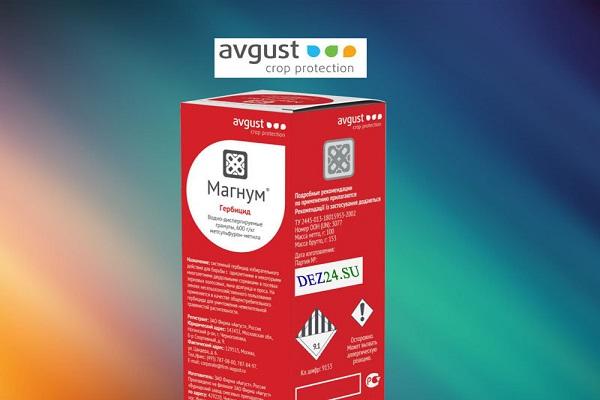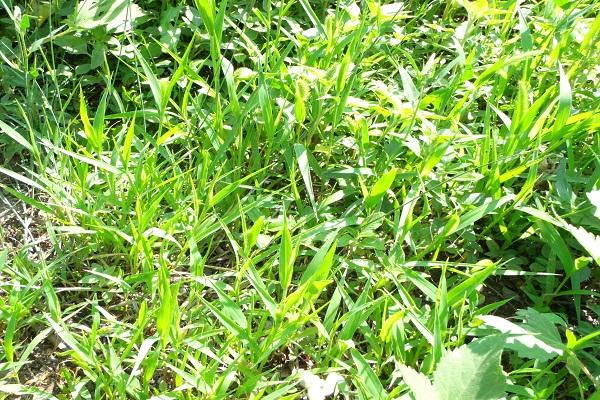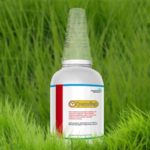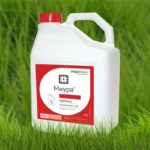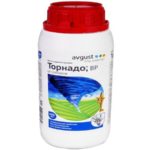Magnum is a systemic herbicide that penetrates the weeds and acts at the cellular level. The drug is recommended for use on grain and flax crops. These crops are not afraid of this type of herbicide. The active substance included in the composition acts only on weeds. The herbicide is used in tank mixtures together with chemicals of another class to more effectively destroy vegetation that interferes with the growth of main crops.
- Composition, release form and purpose
- The mechanism of action of the drug Magnum
- Impact speed
- Period of protective action
- Main positive and negative aspects
- Working fluid flow
- Instructions for the preparation and use of the working solution
- Precautions for use
- Phytotoxicity
- Possibility of resistance
- Compatibility
- Terms and conditions of storage of the drug
- Similar means
Composition, release form and purpose
Magnum or Magnum-Super is an effective means for the destruction of annual and a number of perennial dicotyledonous weeds in fields sown with grain (winter and spring) and flax. The herbicide even copes with thistle and thistle.
The drug is produced by the Russian company August. Can be used in large farms for aerial processing of fields. The active substance - metsulfuron-methyl - belongs to the class of systemic herbicides - sulfonylureas. This main component of the drug destroys weeds at the cellular level.
The herbicide is available in the form of water-dispersible granules. Packaging: 100 gram plastic bottles.
The mechanism of action of the drug Magnum
The active substance is absorbed by young leaves and roots of weeds, penetrating inside and suppressing the formation of substances necessary for DNA biosynthesis. As a result of this biochemical process, cell division stops and the plant dies.
Impact speed
Complete penetration of the weeds occurs 4 hours after treatment. The active substance begins to act immediately after entering the plant organs. After a few hours, the weeds stop growing. They die within 1-3 weeks after treatment. Plants experience chlorosis, reddish coloration of leaves, necrosis, and death of the apical bud.
Period of protective action
The drug has a selective and systemic effect and destroys growing weeds throughout the entire growing season.
The first noticeable symptoms of chemical exposure appear 2-3 days after treatment.
It is advisable to use the herbicide before sowing, before or after the emergence of the main crops. The drug is effective in all weather conditions. The grains themselves are resistant to this type of herbicide.
Main positive and negative aspects
Magnum advantages:
- convenient packaging;
- economical consumption;
- high efficiency;
- shows selective activity;
- can be used at the stage of 2-3 leaves and until the end of tillering;
- destroys all major weeds in grain crops.
Disadvantages of use:
- with prolonged use, resistance may appear;
- it is undesirable to use on alkaline soils (long half-life);
- destroys sensitive vegetable crops growing near the sprayer;
- it is forbidden to spray plantings by air near fishery reservoirs;
- after grains, next year vegetables are planted only after deep plowing;
- It is recommended to adhere to crop rotation restrictions.
Working fluid flow
The drug must be dissolved in water before use. Working fluid consumption is 200-300 l/ha (25-50 l/ha for aerial spraying). The drug rate is 0.005-0.01 kg/ha.
Instructions for the preparation and use of the working solution
On the day of application of the herbicide, a working solution is prepared. The drug is used in spring or during the period of active weed growth. The solution can be poured into the tank of a fine dispersion sprayer.
First, a masterbatch is prepared in a small container from a certain amount of herbicide calculated for the area being treated. The sprayer tank is half filled with water, the mixer is turned on and the mother liquor is poured in.Then the container is filled with liquid to the required volume.
Precautions for use
Magnum is not toxic to humans, however, when preparing the solution and when working with the herbicide mixture, you must adhere to safety precautions. Do not inhale vapors or drink herbicide dissolved in water. The treatment must be carried out in a respirator or protective suit. After working with the herbicide composition, you need to wash your face and hands with warm water and soap, and rinse your mouth with a soda solution.
Phytotoxicity
The herbicide has selective activity. Phytotoxic to weeds. Does not show toxicity to grains and flax. Can destroy plantings of sunflower, buckwheat and vegetables.
Possibility of resistance
The drug may develop resistance only after 3-5 seasons of continuous use.
To prevent addiction, it is advisable to use Magnum alternately with herbicides of other chemical classes.
Compatibility
To prepare the mixture when processing grain crops, in addition to Magnum, you can use other herbicides: Demeter, Ballerina, Zernomax, Elastik extra, Herbitox. On flax plantings, the drug can be used with the following chemicals: Herbitox, Lontrel-300, Zellek-Super, Miura.
The herbicide is used on non-cultivated soils in conjunction with the Tornado herbicide. When preparing the working mixture, Magnum is the first to be poured into the sprayer tank.
Terms and conditions of storage of the drug
In tightly closed or unopened original packaging, the herbicide does not lose its characteristics for 5 years from the date of manufacture. The drug must be stored in a special room intended for pesticides. The optimal storage temperature is 5-25 degrees above zero.The herbicidal solution must be completely used on the day of preparation. With longer storage, the mixture loses its properties.
Similar means
You can find other herbicides based on the substance metsulfuron-methyl on sale. For example, Terramet, Laren Pro, Grench. These selective herbicides are used to protect crops from weeds..



